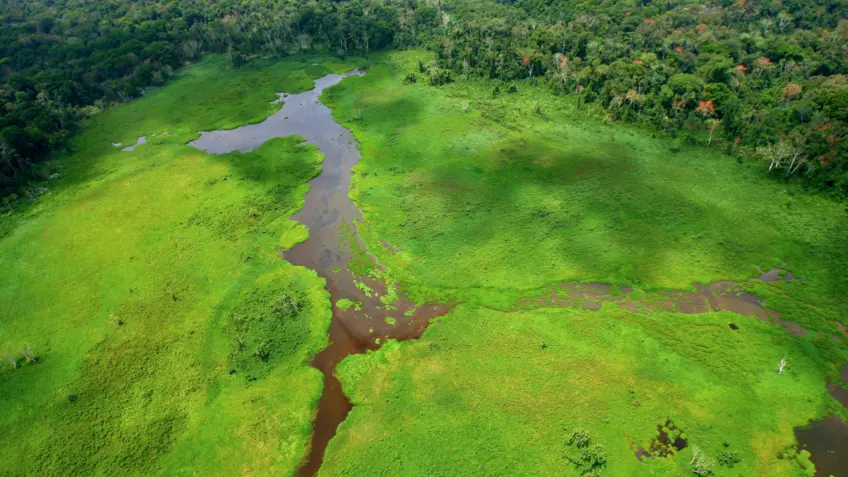Colombia and Panama Eye Carbon Neutrality by 2050
United by geography and similar vulnerabilities at the cross-roads of the Americas, Colombia and Panama have a common climate vision. Both countries submitted 2020 NDCs this month with pledges to become carbon neutral by 2050. These integrated visions of more resilient futures mark these NDCs as steppingstones for green development.
Both countries charted this shared vision by embracing differences in size and local drivers of economic growth. Their embrace of distinctions is typified by their tailored national priorities and broad country-specific consultations.
Through robust technical work, months of dialogue across sectors and societal levels, and support from NDC Partnership members, both countries have set forward more ambitious climate commitments than their first NDCs at all levels and in all sectors. This effort was particularly new for Panama, which drew on the NDC Partnership’s Climate Action Enhancement Package (CAEP) to mobilize consultations across its 10 priority sectors.
“With the execution of these new sectoral arrangements that we pursue in the medium term, every public or private initiative or activity developed in the country integrates climate as an intrinsic variable, from the early stages of the idea design and planification,” said Milciades Concepcion, Panama’s Minister of Environment.
The CAEP supported sectoral consultations, generating relevant and more ambitious 2020 NDC commitments. Similar support in Colombia and official NDC commitments unpin the shared emphasis on forestry, energy, and more comprehensive climate change adaptation approaches. Colombia and Panama’s shared entry points could trigger long-term resilience and decarbonization.
Forests at the center of enhanced NDC ambition
Both Colombia and Panama host some of the most pristine and biodiverse forests in the world, but deforestation and forest degradation seriously threaten ecosystem integrity. Deforestation and forest degradations are also a leading cause of climate change, representing around 30 percent and 15 percent of the respective countries’ emissions.
Both countries are keen to address biodiversity loss and climate challenges. Panama plans to restore 50,000 ha of national forests, which will contribute to the absorption of approximately 2.6 million tons of CO2eq by 2050. Panama aims to achieve this by 2025 with its National Plan for Forestry Restoration and integrated Technical Guidance for the land use sector. Both integrated efforts cover mitigation and adaptation and have been supported by the FAO, the World Bank, and other NDC Partnership members.
Equally ambitious actions are underway, covering all emission sources in Colombia, which pledged to cut emissions by 51 percent compared to Business as Usual (BAU) by the end of this decade. This is an unprecedented national policy milestone, which leveraged global expertise and resources through the NDC Partnership, including support from UNDP, UNEP, the World Bank, and WRI—and reflects the country’s vision of reaching net zero deforestation by 2030.
“Reducing deforestation is one of the main work areas for us to meet our emissions reduction target, and we are working towards it through payments for ecosystem services, stronger enforcement and social projects with local communities,” said Carlos Correa, Colombia’s Minister of Environment.
With this national commitment and support from Germany, Norway, and the United Kingdom, Colombia is set to counter deforestation, restore degraded lands, and improve forest data.
Modernizing and diversifying the energy system
Both nations are also taking bold steps to improve their energy systems. Hydropower significantly contributes to electricity generation in their energy matrix. However, growing vehicle fleets, industrial corridors, and urban centers call for additional, non-conventional renewable sources, more efficient systems, and better practices to meet climate targets and green development objectives.
Colombia will introduce an innovative private sector engagement mechanism inspired by the Chilean experience and based on voluntary NDC implementation agreements in the energy, agriculture, and industrial sectors. This will add to existing measures and support on renewable expansion, demand-side management, and energy efficiency, and will help meet enhanced ambition in Colombia’s most recent NDC. Furthermore, through the NDC Partnership’s Economic Advisors initiative, these and other measures will be mainstreamed into Colombia’s COVID-19 economic recovery. The Finance Ministry projects COVID-19 will reduce Colombia’s 2020 GDP by 5.5 percent. Panama is also marshalling integrated national plans to rebound from the 2 percent decline in 2020 GDP caused by the pandemic.
Likewise, Panama increased its target to cut energy sector emissions by more than a tenth (11.5 percent or more) by 2030 and about a quarter by 2050 (at least 24 percent) under BAU. Panama also reaffirms its commitment to produce 30 percent of electricity from renewable sources by 2050, a mission it plans to pursue with strategic guidance from a forthcoming National Climate Change Plan for the energy sector.
In both countries, ambitious and technically sound energy targets have developed with diverse international support through CAEP, including from the European Commission, GIZ, FAO, WWF, and NREL.
Cross-Sectoral Adaptation and Long-Term Strategies
Both Colombia’s and Panama’s updated NDCs have an integrated vision of resilience and progressive emissions reduction towards carbon neutrality by 2050 with sectoral prioritization. From a policy perspective, both countries have taken big steps to tackle climate change adaptation while promoting sustainable development.
For the first time, Panama includes adaptation priorities to design climate-resilient communities and ecosystems and develop risk mitigation measures in the human settlements, public health, and sustainable infrastructure sectors. Similarly, Colombia’s 2020 NDC embraces a broader, more comprehensive set of adaptation targets with well-defined, traceable policy and action deliverables covering all sectors and needs, which will be included in the country’s Monitoring, Reporting and Verification (MRV) system. These are visionary commitments, rather than one-off commitments. The NDC Partnership remains committed to supporting this ambitious national climate agenda.
This blog was written by the NDC Partnership Support Unit
